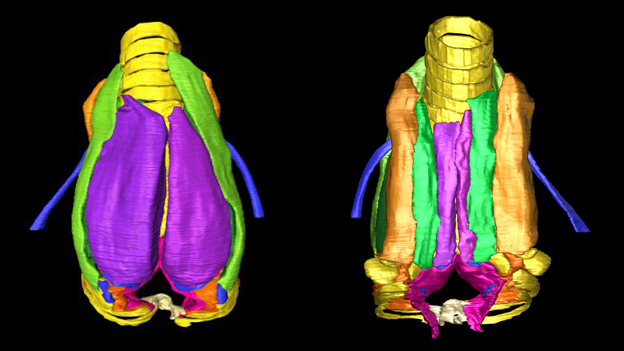Filtered By: Scitech
SciTech
Knowing how the songbird sings — thanks to 3D
By SHAIRA PANELA, GMA News

A songbird's syrinx, rendered in 3D. Photo from the BBC
You don't need 3D glasses to learn how songbirds create music; scientists in Denmark have got you covered.
Danish researchers studied zebra finches and constructed a high-resolution, three-dimensional dataset of their syrinx, a vocal organ located where the windpipe goes to the lungs.
In its study "The songbird syrinx morphome: a three-dimensional, high-resolution, interactive morphological map of the zebra finch vocal organ" published in the journal BMC Biology, the team led by Dr. Coen Elemans combined invasive and non-invasive methods to create a 3D model of the bird's vocal organ.
"This study is the first step in trying to understand the physics of how zebra finches sing," Elemans told GMA News Online.
Birds make "their virtuoso sounds" with the syrinx, said Elemans. "They also have a larynx, but they do not generate sound with it."
How does it work?
Birds live a musical life, singing to communicate—sometimes singing two notes at the same time, and often even when flying.
Elemans' team investigated how birds are able to sing, even in flight.
"We have shown that the bones in the syrinx are adapted for incredibly fast movement," Elemans told the BBC.
"All the tiny bones are made strong but very light, so they can be moved at very high speeds. This enables a male songbird to sing very fast notes very accurately, which the females find attractive," he said.
High-tech learning
Because they learn how to vocalize by imitating their parents, songbirds—especially the zebra finch—have become the best model for scientists to study how this "vocal learning" works, said Elemans.
"Only few animal groups can learn their vocalizations, and if we want to understand the diseases related to speech and language production, we need a good model," he told GMA News Online.
Using a songbird native to central Australia, Elemans' team was able to come up with detailed 3D models through high-resolution imaging techniques like magnetic resonance imaging and micro-computed topography.
"Ultimately we want to understand how the signals from the brain are translated into sound," Elemans said. "Now we have a great map to guide us and study what the function of individual muscles is. Although we do not yet know which muscle contracts exactly as the bird sings, we now have a better understanding of how these 14 muscles can work together. This is a crucial step to understand how the brain controls sound and turns sound it into those beautiful songs we are all so familiar with.”
The knowledge the scientists have gleaned from the mapping has very useful applications. "[W]e can start building computer models based on realistic shapes. Such models can be useful to design prosthetics for people who lost their voicebox," said Elemans. — BM, GMA News
Danish researchers studied zebra finches and constructed a high-resolution, three-dimensional dataset of their syrinx, a vocal organ located where the windpipe goes to the lungs.
In its study "The songbird syrinx morphome: a three-dimensional, high-resolution, interactive morphological map of the zebra finch vocal organ" published in the journal BMC Biology, the team led by Dr. Coen Elemans combined invasive and non-invasive methods to create a 3D model of the bird's vocal organ.
"This study is the first step in trying to understand the physics of how zebra finches sing," Elemans told GMA News Online.
Birds make "their virtuoso sounds" with the syrinx, said Elemans. "They also have a larynx, but they do not generate sound with it."
How does it work?
Birds live a musical life, singing to communicate—sometimes singing two notes at the same time, and often even when flying.
Elemans' team investigated how birds are able to sing, even in flight.
"We have shown that the bones in the syrinx are adapted for incredibly fast movement," Elemans told the BBC.
"All the tiny bones are made strong but very light, so they can be moved at very high speeds. This enables a male songbird to sing very fast notes very accurately, which the females find attractive," he said.
High-tech learning
Because they learn how to vocalize by imitating their parents, songbirds—especially the zebra finch—have become the best model for scientists to study how this "vocal learning" works, said Elemans.
"Only few animal groups can learn their vocalizations, and if we want to understand the diseases related to speech and language production, we need a good model," he told GMA News Online.
Using a songbird native to central Australia, Elemans' team was able to come up with detailed 3D models through high-resolution imaging techniques like magnetic resonance imaging and micro-computed topography.
"Ultimately we want to understand how the signals from the brain are translated into sound," Elemans said. "Now we have a great map to guide us and study what the function of individual muscles is. Although we do not yet know which muscle contracts exactly as the bird sings, we now have a better understanding of how these 14 muscles can work together. This is a crucial step to understand how the brain controls sound and turns sound it into those beautiful songs we are all so familiar with.”
The knowledge the scientists have gleaned from the mapping has very useful applications. "[W]e can start building computer models based on realistic shapes. Such models can be useful to design prosthetics for people who lost their voicebox," said Elemans. — BM, GMA News
Tags: songbird
More Videos
Most Popular



